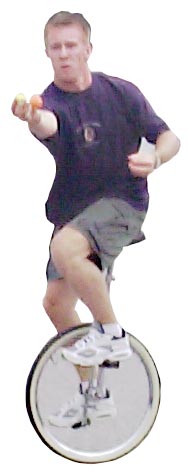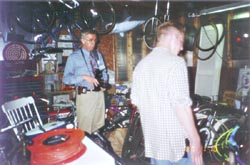Maryland’s First Ladies Stood
by Their Man — er — Guv
Eugenia Byrnes O’Conor, First Lady of Maryland from 1939-’47, was one of five painted by Stanislav Rembski in 1961.
On becoming first lady, Frances Hughes Glendening soon discovered how little was known of the first ladies before her. “There wasn’t even a complete listing of their names,” she said. With the help of the Maryland Archives, Glendening set out to fill in the gaps in history.
For Women’s History Month, Glendening honored 54 of these women. The ceremony launched Glendening’s latest exhibit, “Lady of the House: First Ladies and Official Hostesses of Maryland 1777-2000.” Displayed in it for the first time, says Glendening, are “these vital women and their significant contributions to Maryland.”
The collection of portraits belongs to the Maryland Archives, and the exhibit is the subject of a book forthcoming from the Archives, If These Walls Could Speak: The Official Residences and Public Lives of Maryland’s First Ladies and Official Hostesses, 1777-2000. (You’ll be able to see the exhibit on the web in about a month, and the book in the fall. Look under Government House at [email protected].)
The portraits span the centuries. In one, a serene, young Mary Digges Lee — first lady in the 1780s and again in the ’90s — collects money and supplies for the Army of the American Revolution. Then there’s Anna Maria Tilghman Chew, official hostess for her brother-in-law William Paca, and renowned for throwing a memorable ‘rout’ or party. Patricia Donoho Hughes set about renovating Government House public rooms to reflect Maryland history, highlighting the talents of Maryland artists and craftsmen. In the 1980s, she formed the Government House Trust to carry out the designs.
In the painting of Hilda Mae Snoops, official hostess for William Donald Schaefer, the controversial Victorian-style outdoor fountain she commissioned is subtly reflected through a window. The controversy is now long faded, and the striking fountain with Maryland motifs compliments the rose garden and walkways Snoops helped design.
Displayed, too, is the red lace brocade gown Frances Hughes Glendening wore in 1995 to celebrate her husband’s first inauguration.
Glendening said her vision for the exhibit came in part from Helen Avalynne Gibson Tawes, first lady from 1959-1967, “who truly inspired me.” Tawes had also worked to preserve the legacy of first ladies before her and to recognize their achievements. “A governor’s wife comes here and she works like a dog. I just feel that they get so little credit, some recognition would be nice,” said Tawes in 1961.
“Mrs. Tawes lobbied the legislature for money for past portraits and instituted the custom of having official portraits made of every first lady,” says archivist Emily Oland Squires, who curated the exhibit.
Which is why five portraits were painted in 1961, all by artist Stanislav Rembski. His stunning portrait of Tawes herself hangs in a place of honor in the governor’s residence, over the mantle in a room painted deep red with Oriental carpet, a crystal chandelier and period furniture.
Painted at the same time were the four first ladies before Tawes. Though they’d been younger when they were first ladies, the three surviving ladies sat in person rather than offering an earlier photograph. This, says Squires, gives greater vitality to the portrait and is especially praiseworthy “in a society so youth oriented.”
Thereafter, each first lady has sat for an official portrait, as will Glendening.
The Glendenings welcomed 300 guests to the exhibit, greeting each personally in the doorway of Government House. The line stretched out into the garden and the chilly night air. Inside in the warmth, guests juggled plates of roast beef and pasta, sat on antique chairs and sofas and sipped Maryland wines while admiring portraits and antique silver services on exhibit.
Introducing his wife as a “crusader of women’s history who set new standards as an active and involved first lady,” the governor admitted that he did the washing and ironing at home. After all, the first lady — a lawyer with the Federal Election Commission as well as a champion of the arts, children’s and women’s issues and mental health — is a busy woman.
But not too busy to “celebrate the women who made contributions to our social, political and economic order.” Glendening says she celebrates women’s history “every day, all year long.”
Francis Hughes Glendening is leaving her own legacy to Maryland history. She turned over to the Maryland Archives a set of 11 books detailing what she had done as first lady. No doubt there will be more to come from the lady who recalled that Nancy Reagan was the only woman to describe herself as “First Lady” on her tax return.
See “Lady of the House: First Ladies and Official Hostesses of Maryland” at Government House (next to the State House) until May 24 on Tuesdays, Wednesday and Thursdays. Until April 10, when the General Assembly closes, see the exhibit by appointment on Tuesdays and Thursdays: 410/974-3531.
Stay Out All Night and Feel Good
Stay out all night, have a great time and feel good about yourself in the morning at the American Cancer Society’s “Relay For Life,” a 16-hour overnight festival to raise money for cancer research.
Cancer survivors will walk the first lap of the relay on Friday, June 9, at Southern High School’s athletic field. Then teams will walk in relay. Eight to 15 people make up a team, and at least one member must be awake and walking at all times.
The relay begins at 6pm, with a luminary ceremony of candles at 9pm. A $10 donation purchases a candle to support a friend or family member fighting cancer.
To further support the American Cancer Society, each team member pays a $10 commitment fee and, ideally, sponsorships worth at least $100.
During the relay, the sports field becomes a carnival, with each team bringing a tent decorated in a festive theme. The tents also give team members a headquarters and a place to rest when they’re not walking the track. Costumes echo each theme.
Best themes win prizes for their teams, as do highest contributions, both team and individual. All walkers get a Relay for Life T-shirt.
Walkers and spectators alike will be treated to tasty foods and live entertainment including music, games, giveaways and contests.
This year marks Southern Anne Arundel County’s first Relay For Life, and organizers trust you’ll dust off your walking shoes and form a team.
To learn more: Liz Knapp at the American Cancer Society 301/261-6000. Local contacts are Jack and Sherri Hennen: 410/798-6304.
Anne Arundel Gets Enviro Gold
So good is Anne Arundel County’s work for the Bay that the county has vaulted from silver to gold in the Chesapeake Bay Partner Communities Program.
The four-year-old Partners Communities Program recognizes local governments that protect and preserve the Bay with gold, silver and bronze awards.
Communities are evaluated in six categories:
- Development that Works;
- Preventing Pollution;
- Conserving and Preserving Living Resources;
- Valuing Trees and Forests;
- Conserving the Countryside;
- Revitalizing the Communities and Community Participation;
Among 13 counties, towns and cities from Virginia to Pennsylvania, Anne Arundel County is one of three Maryland communities taking the gold.
First Person:
Confessions of a Teenage Bike Junkie
 by Russ Pellicot by Russ Pellicot
“Hurry up! Can’t this thing go any faster?” I yelled as my father and I chased another pickup truck down Muddy Creek Road. Loaded down with brush, old shingles and garbage, the truck ahead was obviously on its way to Sudley Landfill, but not all of its cargo was destined to make it there. Perched atop the pile of trash was a treasure: an adult-style, full-sized, three-wheeled bike.
Imagine the possibilities!
After what seemed like miles of flashing our lights and honking, my father and I got the driver to pull over. He’d been afraid that his load was blowing out all over the place, but he calmed down when we told him that it was the junked bike we were after.
We unloaded the crusty cruiser and carted it home. That bike, with its rusty blue paint and three-speed hub, became my obsession, consuming all my free time and a good 90 percent of my spare parts. I saw it through, from derelict to roadworthy, and then rode the wheels off it.
I have a confession to make. I’ve never seen a bicycle I didn’t want.
It all started when I was a boy of 10 or 11 years old. I was just learning how a bicycle worked, experimenting with repairs and tinkering here and there. A garage full of tools and a desire to learn was all it took to start the obsession. The addition of more and more bikes to my stable took an innocent hobby to a full-blown addiction. What began as curiosity evolved into much more than I could have imagined.
Once I started scavenging bikes, I needed more. More bicycles, more parts, more tools, more everything. I’d ride around the neighborhood for hours looking for bicycles in curbside garbage. Other places good for finding treasures were yard sales, friends, bike shops, mail order catalogs and the Internet. For four years, I spent nearly every waking hour in pursuit of the quintessential human-powered vehicle.
My cycle addiction wasn’t satisfied by the mainstream, two-wheeled kind. I needed weird bikes to get the fix I really craved. These machines were multi-wheeled, extremely low (or high) riders, restored antiques and wild customs. You name it; I rode it.
After a while, the weirdness just wasn’t enough. I needed these things to look nice. Exotic paint jobs and gobs of polished chrome were what I was after.
When a friend showed me pictures in a magazine of lowrider bikes, I had to have one. Not being rich enough to lay down the dough for a gold-plated this and a velvet-covered that drove me to seek out my next project. I found another three-w heeler sitting idle in someone’s backyard. heeler sitting idle in someone’s backyard.
This one was in great shape compared to the last, and it came complete with chrome fenders. I was surprised to see chrome look so good after being out in the weather for so long. I decided to give it a complete, ground-up customization. It was all I thought about and all I worked on. Frame modifications and custom paint, a ’50s’ style springer front suspension and chromed-skull tire valve caps are just a few of the customizations that made this bike the ultimate neighborhood cruiser.
My obsession did not end there. Fueled by how well my custom trike came out, I wanted something bigger, literally. The owner of now-defunct South River Cycles, Dave Perka, had built an upside-down bike to promote his business. An upside-down bike is made of two frames that have been welded together, and it stands a good five feet high. With my dad doing the welding and me doing the assembly, we had our own copy within a month and a half.
Deep puddles no longer fazed me. The neighborhood kids were dumbstruck. If I had a nickel for every time I’ve answered “How do you get up there?” (kind of like mounting a horse) I’d be rich.
By this time, my friends and family knew I was addicted, but nobody tried to stop me. I was on top of the world. I could ride anything, unicycles and all. At its peak, my bicycle collection rivaled that of the local bike shop, topping out at around 35. The total included four three-wheelers, a bicycle built for two, two lowriders, a unicycle, several 10-speeds, beach cruisers and mountain bikes.
Eventually, my addiction was cured by a ’66 Ford Fairlane and a wallet-sized laminated card. This was a whole new way to get around, and with it came bigger and faster machines to tinker with.
The only reminder I have left of the life I once led is the GT Performer — customized for stunt riding — that now sits in the garage with a flat tire. Now if I could only sell some of these bike parts and get some more cars — with custom wheels and loud exhaust …
Calvert County Gets a Space Place
You can learn to make a balloon-powered asteroid nanorover on Space Place’s web site.
Calvert County denizens might be surprised to find a National Aeronautics and Space Administration satellite based right in their own back yard.
Only this satellite doesn’t orbit.
Prince Frederick’s Arthur Storer Planetarium, long a local hot spot for school field trips and armchair stargazers, is expanding its repertoire to include a Space Place. Developed by NASA, the new science program includes 100 sites across the country. They, in turn, channel the vast stores of NASA know-how into local classrooms from kindergarten through high school.
For now it’s a static enterprise. The only tangible evidence is literature for the taking at the planetarium, offering lore ranging from explanations of ion propulsion to how to make a balloon-powered asteroid nanorover.
“Basically, they provide a bulletin board and send you updates,” explains Shawn Laatsch, director of Arthur Storer Planetarium. “They also have a website and send activities to distribute to schools. We’re trying to reach students in new ways.”
Outreach gets more interactive this summer. A few special programs at the planetarium are in the works, including probable kids’ camps. In the meantime, you can find a sample of said enlightenment at http://spaceplace.jpl.nasa.gov.
Pawned Prizes: Big Stuff on the Auction Block
Pawn shops sell things like jewelry, musical instruments, electronics and sporting goods, right? Not forklifts, lathes, milling machines and huge woodworking machinery.
Yet that’s what you’ll find at Parkway Pawn, in Bladensburg, but not for long. Most of the 20,000 square feet of merchandise needs to be cleared out by the end of April.
To liquidate that enormous inventory quickly, Parkway Pawn hired Doug LaFoille, a former Prince George’s County policeman and now owner of The Auction Block at the Dock, in Manistique, Michigan.
LaFoille called on Col. Irv Sass of the Baltimore Auction Co., Inc. and Col. Bob Hendrickson of Annapolis to inspect the inventory and to help conduct the March 25 and 26 on-premises sale.
Sass believes there are over 10,000 items in inventory at Parkway Pawn, which started small but grew to fill two floors of a former chain supermarket store. Most of the stuff will be sold at the two-day auction with two auction rings running simultaneously.
“There’s something here for everyone,” Sass said.
“Mind-boggling,” added Hendrickson.
You’ll find electronics, hand tools, small power tools, drill presses, milling machines, lathes, surface grinders, joiners, planers and welders. Compressors, pressure washers, cement tools, tampers, air tools, plumbing, heating, lighting and air-conditioning equipment, supplies and tools, too.
Also golf clubs, an inflatable boat, skis, Olympic weights, Nautilus and other exercise equipment and lots of bicycles. Don’t forget keyboards, amps, mixers, speakers, guitars and other musical items.
Not to mention restaurant stoves, refrigerators, soup makers, slicers, espresso machines, and ovens filling another section. And forklifts, pallet jacks and pallet wrapping tables.
Last but not least are two low mileage Honda motorcycles. One is the popular Gold Wing model, considered a classic by many.
Hendrickson, who conducted a major tool auction last year, said his two-day sale of woodworking and auto tools and equipment was minor compared to this sale.
Said Hendrickson, “This has to be the mother of all tool auctions in this part of the country.”
Way Downstream …
In Chesapeake, Va., a farm field that had been drained and planted long ago has been restored to where it is once again considered a wetland, the Nature Conservancy reported last week. The land is moist and muddy and “teeming with wildlife” thanks to a joint venture with the Virginia Wetlands Restoration Trust Fund and the Army Corps of Engineers …
In Washington, Southern Maryland’s U.S. Representative, Steny Hoyer, must be feeling “safe” these days. He opposed Vice President Al Gore and environmental advocates when he voted in the House for a property-rights bill that would make it easier for developers to challenge state and local zoning decisions …
In Yellowstone National Park, the results of a study are in and the biggest polluters in the park are … snowmobiles. A report issued by the National Park Service found that snowmobiles contribute more than two-thirds of hydrocarbon pollution and roughly half of carbon monoxide — both more than automobiles …
Our Creature Feature comes from Colorado, where Tarzan and would-be Janes in a herd of ostriches are a bit ruffled these days by the city’s installation of a water pipeline. Too ruffled, it seems, to mate.
So Tarzan’s owner, Steven Peper, last week went to court and won a temporary restraining order against the city of Longmont from proceeding. Peper may or may not have summed up the temperament of males in general when interrupted by noisy machinery in romantic moments. “These guys are very sensitive,” he said.
Copyright 2000
Bay Weekly
|